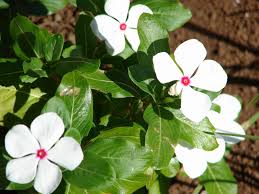Catharanthus roseus--நித்தியக்கல்யாணி
CANCER KILLING SUPPORTING HERB
 Catharanthus roseus, commonly known as the Madagascar periwinkle, is a species of Catharanthus native and endemic toMadagascar. Other English names occasionally used include Cape periwinkle, rose periwinkle, rosy periwinkle, and "old-maid".
Catharanthus roseus, commonly known as the Madagascar periwinkle, is a species of Catharanthus native and endemic toMadagascar. Other English names occasionally used include Cape periwinkle, rose periwinkle, rosy periwinkle, and "old-maid".
http://www.sidhhaherbs.blogspot.com
Scientists who were intrigued by the fact that traditional Madagascan healers used rosy periwinkle to help treatdiabetes decided to research other potential medicinal uses for the plant. They discovered hidden treasures within rosy periwinkle, in the form of chemicals that they could use to create medicines for cancer patients.
Miraculous Results:
The chemicals from rosy periwinkle that are used in medicines, which are called vinca alkaloids, have reduced children’s leukemia survival rates so dramatically that some people call rosy periwinkle a miracle plant. Before vinca alkaloids were discovered, the average survival rate from children’s leukemia was just 10 percent. But now that doctors can treat children with drugs made from vinca alkaloids, about 95 percent of all children with leukemia survive.
In the wild, it is an endangered plant; the main cause of decline is habitat destruction by slash and burn agriculture. It is also however widely cultivated and is naturalised in subtropical and tropical areas of the world.
The species has long been cultivated for herbal medicine and as an ornamental plant. In Ayurveda (Indian traditional medicine) the extracts of its roots and shoots, though poisonous, is used against several diseases.[citation needed] In traditional Chinese medicine, extracts from it have been used against numerous diseases, including diabetes, malaria, and Hodgkin's lymphoma.The substancesvinblastine and vincristine extracted from the plant are used in the treatment of leukemia and Hodgkin's lymphoma.
This conflict between historical indigenous use, and recent patents on C.roseus-derived drugs by western pharmaceutical companies, without compensation, has led to accusations of biopiracy.
The species has long been cultivated for herbal medicine and as an ornamental plant. In Ayurveda and Siddha (Indian traditional medicine) the extracts of its roots and shoots, though poisonous, is used against several diseases.
In traditional Chinese medicine, extracts from it have been used against numerous diseases, including diabetes, malaria, and Hodgkin's lymphoma. The substances vinblastine and vincristine extracted from the plant are used in the treatment of leukemia and Hodgkin's lymphoma.
The species has long been cultivated for herbal medicine and as an ornamental plant. In Ayurveda and Siddha (Indian traditional medicine) the extracts of its roots and shoots, though poisonous, is used against several diseases.
In traditional Chinese medicine, extracts from it have been used against numerous diseases, including diabetes, malaria, and Hodgkin's lymphoma. The substances vinblastine and vincristine extracted from the plant are used in the treatment of leukemia and Hodgkin's lymphoma.
It can be dangerous if consumed orally.
It can be extremely toxic, and is cited (under its synonym Vinca rosea) in Louisiana State Act 159.
C. roseus is used in plant pathology as an experimental host for phytoplasmas. This is because it is easy to infect with a large majority of phytoplasmas, and also often has very distinctive symptoms such as phyllody and significantly reduced leaf size.
physicianpackiam
http://www.sidhhaherbs.blogspot.com

No comments:
Post a Comment